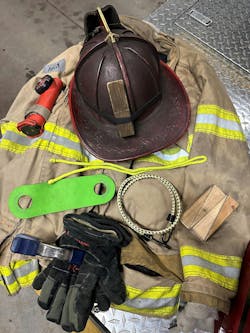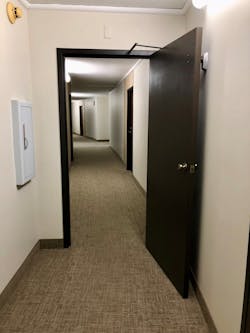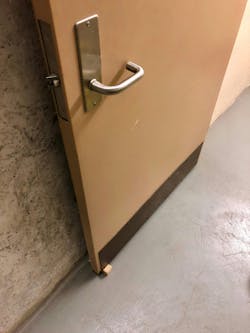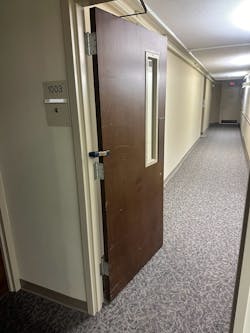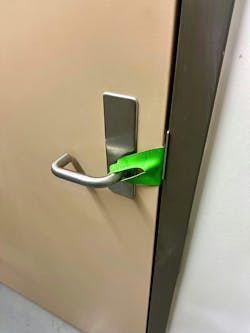Engine Essentials: Chock Talk
A critical component of engine company firefighters’ equipment is a means to secure doors in the open position when they stretch handlines. Numerous tools and techniques are available to accomplish this task, but firefighters must consider several important factors when they employ the various methods. Firefighters also must weigh the unintended consequences of fire development and/or smoke spread throughout the structure when they decide which doors should be secured in the open position.
Doors to secure open
The decision to secure a door in the open position must be evaluated judiciously by the engine company. In general, if a hoseline is stretched or advanced through a doorway, the door should be secured firmly in the open position. Failure to properly secure such a door can prove disastrous on the fireground.
A couple of building construction features generally dictate whether a door through which a hoseline passes must be secured open: the swing of the door and the presence of self-closing hardware. Another factor that must be considered is the location that the hoseline is stretched to—interior or exterior of the structure—prior to the hoseline being charged.
At dwelling fires, most entry and interior doors are inward opening and lack self-closing hardware. The lack of self-closing hardware means that these doors aren’t as likely to close on the advancing hoseline if they aren’t secured open as doors that have self-closing hardware are. Being inward opening, the movement of a charged hoseline into the structure normally keeps the door in the open position. The attack hoseline usually is charged outside of the dwelling and then advanced interior. Thus, lack of water because of a door closing on an uncharged line that’s stretched interior isn’t a major concern, compared with other occupancies that are discussed below.
Screen and security doors, which are common at dwelling fires, are outward opening and possess self-closing hardware. Often, the mechanisms to secure these doors in the open position are broken, missing or allow them to easily close if the door is bumped. A partially closed door can impede or completely stop the advancement of the hoseline into the structure. If a screen or security door is encountered, it must be secured in the open position or removed.
At apartment buildings, commercial buildings and high-rises, outward opening doors and doors that are equipped with self-closing hardware are encountered frequently. Firefighters often must stretch a dry hoseline to remote areas of the building prior to it being charged. If these doors aren’t secured open properly, they can easily close on the uncharged hoseline, which greatly reduces or prevents flow at the nozzle once the hoseline is charged. In addition, water that’s in a now-charged hoseline can prevent the door the line is trapped under from opening, potentially trapping firefighters behind the door with no water. This is a true engine company emergency. The only way to open the door is to drain the hoseline. With long stretches, the hoseline can’t be drained rapidly at the pump; the couplings are under pressure, which makes them extremely difficult to break. This emergency is exacerbated when the incident involves standpipe operations, because the system can’t be drained easily. (Author’s note: Elkhart Brass designed an elbow that has a drain that’s placed on the standpipe outlet to address such emergencies.)
A common cause of this emergency are electromagnetic door closures on fire doors, which cause the doors to close when the alarm system is activated.
A frequent occurrence at apartment fires involves only the fire apartment smoke detector sounding. Such a smoke detector isn’t tied to the central station alarm, thus allowing fire doors to remain in the open position. When smoke enters the hallway and triggers a smoke detector that’s tied to the central station or when a pull station is activated, fire doors will close automatically. If a dry hoseline was stretched through a door that wasn’t secured open, the line can become trapped underneath easily.
Doors to leave closed
Over the years, the National Institute of Standards and Technology and UL’s Fire Safety Research Institute examined flow paths through various types of structures. Firefighters must consider how their actions will allow smoke to spread, particularly when dealing with apartment buildings and high-rises.
Two recent fires brought this topic to the forefront. In both circumstances, a large loss of life was attributed to self-closing fire doors failing to close or being secured in the open position.
The June 14, 2017, Grenfell Tower fire in London resulted in 72 deaths. A post-fire investigation of the incident revealed that open fire doors resulted in smoke spread. As part of the investigation, the actions of firefighters both opening and securing doors in the open position for firefighting operations were discussed.
A fire that occurred on Jan. 9, 2022, in New York City resulted in 17 deaths. As part of the investigation of the Twin Parks fire, an open fire apartment door and an open stairwell door that was on the 15th floor were identifed as primary reasons for smoke spread.
Self-closing fire doors in hallways, stairwells and apartments are designed to compartmentalize a fire to prevent or reduce smoke and fire spread to other areas of the building. Firefighters should minimize the disruption to this compartmentation by keeping fire doors closed if they won’t affect the stretching, charging or advancing of the hoseline.
In apartment buildings and high-rises, firefighters should designate attack and evacuation stairwells. The attack hoseline should be stretched via the attack stairwell. This stairwell will become contaminated with products of combustion because of doors being secured open for the hoseline. Firefighters should strive to ensure that all stairwell doors that lead to the attack stairwell, with the exception of those through which the hoseline is being stretched or advanced, are kept closed to minimize smoke spread to other floors.
All evacuation of occupants should be carried out via the evacuation stairwell. None of the doors that lead to this stairwell should be secured in the open position. Fire doors that are in the hallway of the fire floor leading toward the evacuation stairwell should also be kept closed if they won’t affect the stretching and advancing of the hoseline.
The means to secure open
Firefighters should have the ability to secure several doors in the open position. On the fireground, it isn’t uncommon to encounter multiple doors that must be secured open. For example, at an upper floor apartment fire, firefighters frequently pass through five or more doors that are equipped with self-closing hardware: the entry door, lobby door, lower stairwell door, upper stairwell door and the door to the fire apartment.
In addition to having the ability to secure multiple doors, firefighters should carry various methods to hold open the different types of doors that they encounter in their district. The methods that are selected should be capable of firmly holding doors open, easy to place and remove, light and easy to carry, and inexpensive, because they often are lost on the fireground. Thought also should be given to various methods that allow a door to be closed but not latched/locked to facilitate access yet minimize smoke spread.
The selected methods should be carried in readily reachable areas. Firefighters should set up their gear to be able to easily deploy the selected methods while opening doors and carrying other essential fireground equipment.
Door chocks
The wooden door chock is the standard means in the fire service to secure doors. It meets all of the requirements: firmly holds the door, easy to deploy and remove, lightweight and inexpensive. A door chock can be made easily at the firehouse using a two-by-four and a saw. When cutting chocks, make sure they’re thick enough to accommodate a variety of standard doors.
When deploying a chock, it should be placed under the door on the latch side. This ensures the best holding capability and can be placed quickly with a foot from a standing position. Avoid placing a chock that’s balanced on hinges or at the top of the door, because it can fall out if the door is bumped.
Placing the chock under the door allows for rapid removal from a crouched position if conditions were to change and the door must be closed.
Spring clamps
Standard 2-inch or larger spring clamps that are found at hardware stores serve multiple purposes. They can be used to hold firefighting gloves when not in use, secure doors in the open position and secure doors in a nearly closed but not latched/locked position.
Spring clamps can be placed on the hinge side of the door once opened. This firmly holds the door in a fully open position. This works well in a situation where a standard wood chock isn’t tall enough for the door. Spring clamps are easy to reach when clipped to turnout gear but are more difficult to place and remove than a standard wedge is.
The spring clamp can also be placed on the latch side of the door. This allows for the door to mostly close, which minimizes smoke spread but prohibits the door from latching/locking. This is important, because many exterior doors, apartment doors and even stairwell doors lock automatically when they are closed.
Latch straps
Latch straps commonly are made of rubber or other stretchable material. They are light and easy to carry in a turnout gear pocket. Similar to spring clamps, latch straps allow a door to be closed but not latched/locked. The benefit of a latch strap over a spring clamp is that a latch strap allows a door to be fully closed, which further minimizes smoke spread but still allows access to the area on the other side.
Bungee cords & gear ties
Bungee cords and flexible gear ties can be used to rapidly secure open screen doors and security doors. As noted above, the hardware on these doors often fails to ensure that the doors remain open. Although these doors can be removed with standard forcible entry tools, the use of a bungee cord or gear tie to hold them open often is a much faster process.
Advanced analysis
Engine company firefighters must carry the means to secure multiple doors open to facilitate the stretching and advancing of the hoseline. Careful consideration must be given to the potential effect that an open door will have on fire and smoke spread throughout the building. Firefighters must analyze all factors to determine the best course of action to ensure the most effective and safest means of attacking the fire while protecting occupants.
About the Author

Jonathan Hall
Jonathan Hall, who is a Firehouse contributing editor, has more than 24 years of fire service experience. He currently is a captain with the St. Paul, MN, Fire Department assigned to Engine Company 14. Hall also serves as a lead instructor in the department's Training Division; he teaches hands-on skills to members of all ranks. Hall is the co-owner of Make The Move Training LLC and teaches engine company operations throughout the country.
